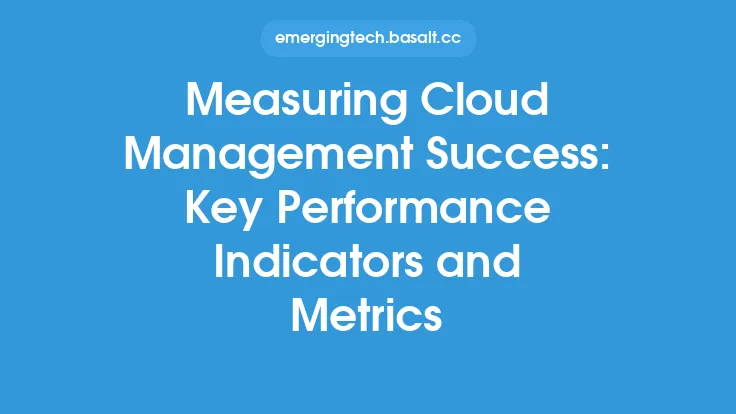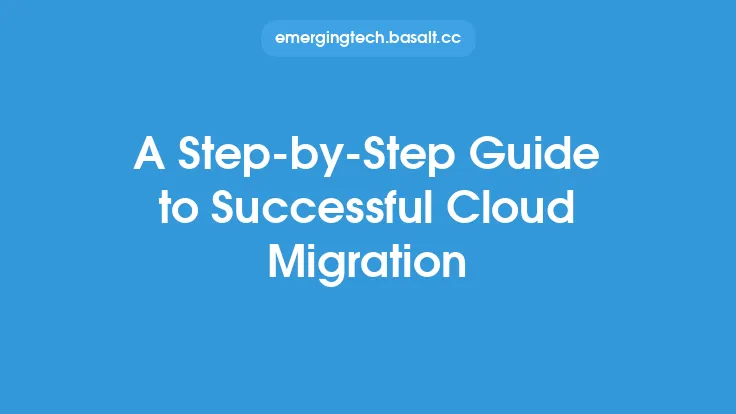As organizations continue to migrate their operations to the cloud, the need for effective cloud governance has become increasingly important. Cloud governance refers to the set of policies, procedures, and standards that ensure an organization's cloud-based assets and services are properly managed, secured, and compliant with regulatory requirements. In this article, we will explore the concept of cloud governance, its importance, and how it can help unlock business value.
Introduction to Cloud Governance
Cloud governance is a critical component of an organization's overall IT governance framework. It involves the establishment of clear policies, procedures, and standards for the management of cloud-based assets and services. This includes ensuring that cloud services are properly configured, secured, and monitored, as well as ensuring compliance with regulatory requirements and industry standards. Effective cloud governance requires a deep understanding of the organization's cloud environment, including the types of cloud services being used, the data being stored and processed, and the security controls in place.
Benefits of Cloud Governance
Cloud governance offers a number of benefits to organizations, including improved security, compliance, and risk management. By establishing clear policies and procedures for the management of cloud-based assets and services, organizations can reduce the risk of security breaches and data losses. Cloud governance also helps ensure compliance with regulatory requirements and industry standards, reducing the risk of fines and penalties. Additionally, cloud governance can help organizations improve their overall IT efficiency and effectiveness, by ensuring that cloud services are properly configured and optimized.
Key Components of Cloud Governance
There are several key components of cloud governance, including cloud security, compliance, and risk management. Cloud security involves the implementation of security controls and procedures to protect cloud-based assets and services from unauthorized access and malicious activity. Compliance involves ensuring that cloud services are configured and managed in accordance with regulatory requirements and industry standards. Risk management involves identifying and mitigating potential risks associated with the use of cloud services, such as data breaches and service disruptions.
Cloud Governance Frameworks
A cloud governance framework is a structured approach to cloud governance, which provides a set of policies, procedures, and standards for the management of cloud-based assets and services. There are several cloud governance frameworks available, including the National Institute of Standards and Technology (NIST) Cloud Computing Reference Architecture, the Cloud Security Alliance (CSA) Cloud Controls Matrix, and the International Organization for Standardization (ISO) 27017 cloud security standard. These frameworks provide a set of best practices and guidelines for cloud governance, which can be tailored to meet the specific needs of an organization.
Implementing Cloud Governance
Implementing cloud governance requires a structured approach, which involves several key steps. The first step is to establish a cloud governance team, which is responsible for developing and implementing cloud governance policies and procedures. The next step is to conduct a cloud governance assessment, which involves identifying the organization's cloud-based assets and services, and assessing the current state of cloud governance. The assessment should identify areas for improvement, and provide recommendations for implementing cloud governance policies and procedures. The final step is to implement cloud governance policies and procedures, which involves configuring cloud services, implementing security controls, and establishing monitoring and reporting procedures.
Cloud Governance Tools and Technologies
There are several cloud governance tools and technologies available, which can help organizations implement and manage cloud governance policies and procedures. These tools and technologies include cloud management platforms, cloud security gateways, and cloud compliance monitoring tools. Cloud management platforms provide a centralized interface for managing cloud services, including provisioning, configuration, and monitoring. Cloud security gateways provide a secure entry point for cloud services, and can be used to implement security controls such as firewalls and intrusion detection systems. Cloud compliance monitoring tools provide real-time monitoring and reporting of cloud services, and can be used to identify compliance issues and risks.
Best Practices for Cloud Governance
There are several best practices for cloud governance, which can help organizations implement and manage effective cloud governance policies and procedures. The first best practice is to establish clear cloud governance policies and procedures, which are communicated to all stakeholders. The next best practice is to conduct regular cloud governance assessments, which involve identifying areas for improvement and providing recommendations for implementing cloud governance policies and procedures. The final best practice is to implement a cloud governance framework, which provides a structured approach to cloud governance and helps ensure compliance with regulatory requirements and industry standards.
Conclusion
In conclusion, cloud governance is a critical component of an organization's overall IT governance framework, which involves the establishment of clear policies, procedures, and standards for the management of cloud-based assets and services. Effective cloud governance offers a number of benefits, including improved security, compliance, and risk management. By implementing a cloud governance framework, and using cloud governance tools and technologies, organizations can ensure that their cloud-based assets and services are properly managed, secured, and compliant with regulatory requirements. By following best practices for cloud governance, organizations can unlock business value, and achieve their cloud computing goals.





